Case Study: Chaperone
Crossing the road to solve a problem.
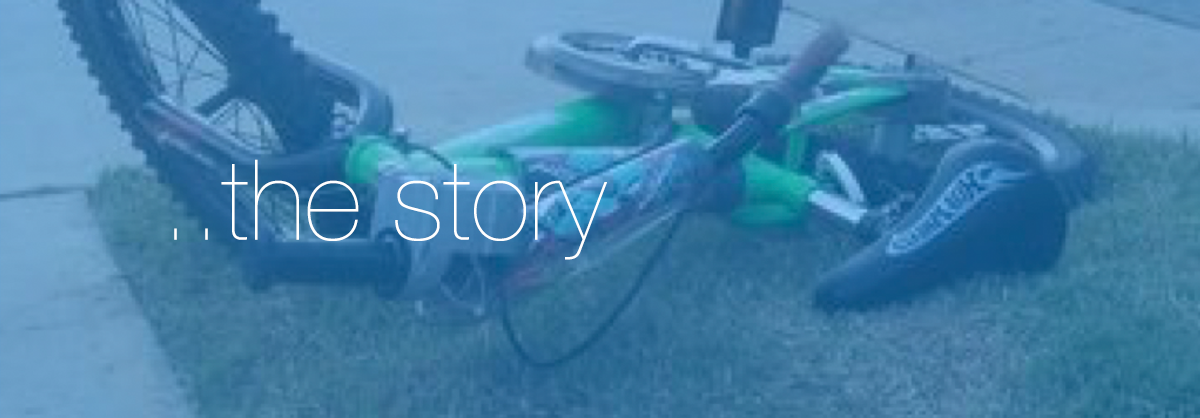
Couple years ago one weekday. I was at work when I received a call from an unknown number. The lady on the other end told me that one of my twin boys was in an accident while biking home from school.
There was this silence. Might have been only for a second but it sure felt like long as all sorts of thoughts rushed in my mind. I think the caller sensed it and she immediately assured me that it was a minor accident and my son was fine, besides bloody knees and shaken up by the incident.
At first I thought it was one of those isolated mishaps and I tried to find a solution just for myself. The more I researched, the more I realized this was a much more urgent problem with no apparent solution and it was not an isolated incident.

![]()
– a person who organizes and operates a business or businesses, taking on greater than normal financial risks in order to do so.
As a Founder/entrepreneur, my primary role was focusing on business that included everything from customer development, marketing to design. Come to think of it, I have been doing this even when I am working only as an experienced designer – first to understand the user needs and then to design an ideal business solution. I lead the team of developers, marketing manager and a junior designer, producing all major deliverables and presenting these to various stakeholders (parents, school admin, PTA, City officials and prospective investors). We developed iOS & Android app and launched in summer of 2016.

Improve kids transportation: I was made aware of this problem by an incident that happened in my personal life. Once we decided to work on this idea full-time, we had two primary objectives – to find an ideal solution to this critical problem that will disrupt the current kids transportation system for the better and help create safer commuting for kids that walk and bike to schools.
Being a bootstrapped startup, we had a limited runway and based on our initial findings, we realized that parents think about ‘transportation’ more so during back to school. We had 6 months to research, strategize, conceptualize, design and launch the app.
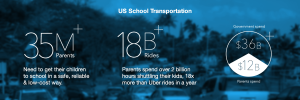
Transportation for kids
There are 58M K-12 students in US and more than 48% commute to school in family cars. These commutes add up to 18B rides per year (that is 18X more than Uber give rides worldwide in a year). Due to traffic congestions and distracted driving there were more than 200 fatalities near schools and the numbers are on the rise.

Before we started sketching ideas, it was important to learn about our users(parents and kids), their routine and activities related to kids transportation. We also needed to understand the current transportation options and environment surrounding it. We first made a list of things we needed to observe, listen and experience ourselves.
Learning
What logistics, circumstances or settings are relevant to school commutes?
Which user types are part of the school commuting ecosystem?
In what way do those users experience the commuting?
Insights
Which parents currently have the most positive experiences with the school commutes?
Which parents currently have the least positive experiences with the school commutes?
Opportunities
In what ways does the school commute currently support positive experiences for different types of users?
In what ways does it not?
Without defining the carpool solution, what positive experiences or benefits could the school commute help support for different users in the ecosystem?


As part of this observation, we spoke to over 1200 parents. Surveyed another 1500 parents and got a deeper understanding about the challenge.
• Due to limited parking and slow moving traffic, some parents parked further up and walked their children to school.
• Traffic get congested between 7:45 AM to 8:15 AM in the morning (drop-off) and 2:50 PM to 3:20 PM in the afternoon (pick-up). Parents were more stressed during drop-off in the morning.
• 7 out of 10 family cars were SUV/Vans, taking up extra space on the road and making it challenging for bikes to share the lane.
• Parents head off to work after dropping their children to school in the morning. Over 30% of the parents took time off from work to pick up their children. Another 50% parent came from home to pick up their child and 20% walked back home.
• Stay home parents seem more relaxed and take the time to interact with other parents and teachers before heading back home after drop-off. Over 65% of these parents were moms.
Some of the key findings from our survey.
• 72% preferred carpooling, yet only 6% parents currently carpooled to school (If an option was provided)
• Parents were aware of Uber/Lyft and regular users but were not comfortable to use it for their children’s transportation needs due to safety and cost concerns.

We realized the solution has to be cheap (free is even better.) without compromising the safety of the child. More importantly, the solution has to be something parents can absolutely trust. But for the parents to adopt this solution, we needed to make the solution convenient, meaningful that has a positive social impact and fun experience worth sharing.
To join a community is human.
Humans are social and crave to belong to tribes. Parents are more open to help each other in the community. Carpooling to school is an age old concepts and parents were aware of its benefits.

There were different types of users and how their interaction made an impact on the community.

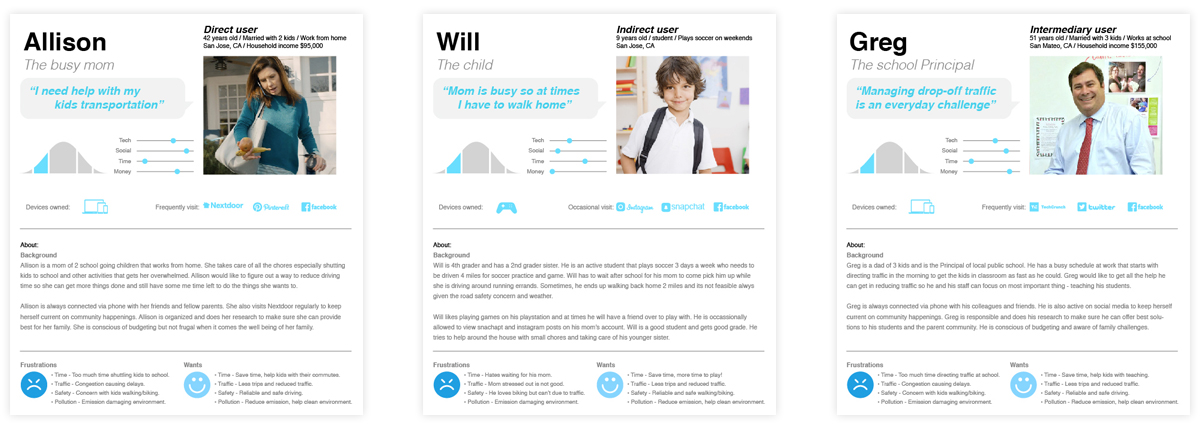

We needed to validate the concept, so we manually paired 18 families from my twin’s elementary school and requested them to carpool for a week as part of our beta test. We simply created a spreadsheet, paired the parents and coordinated the carpools to learn from the experiment.
Result: 62 Rides in the week and took nine cars off the road. Parents save over 7 hours combined. Delivered unlimited smiles.

Encouraged by this experiment and feedback, we quickly did sketches of the user flow and prototyped them for input. This created early team-wide alignment, sparked tons of great ideas and created a strong sense of ownership across different disciplines within our team and the parent community.

Sharing our methods and thinking from the outset helped to build a strong community relationship. Ample opportunities for input at all stages of the project built trust and created a comfortable environment to share ideas — forming a partnership which will serve much value beyond this phase.
Since we were limited with our time and budget, we decided to build the iOS app first. This helped us focus on a single platform and learn from usability testing. Once our iOS app was stable, we were able to create the Android version much faster.
Meeting with key stakeholders such as School admins, PTA, City officials and Kids Safety organizations(SRTS) helped us to understand their challenges. Together we identified risks and aligned on expectations and constructed a shared vision for the app.


It is the first thing users see.
Parents are protective and skeptical when it comes to products/services that are aimed at their children. A carpool service needs to address the concern and offer more than a functional app to build the trust. This understanding helped me to develop a clear vision of my user’s expectations and drive the personality of our brand. We strived towards creating a list of principles that articulate core values and describe key attributes of our app. The principles were used to keep the team on the same page and overall development of the app.

During the initial phase of customer development and research, we tried different names to get feedback. After trying half a dozen names we settled on Chaperone.
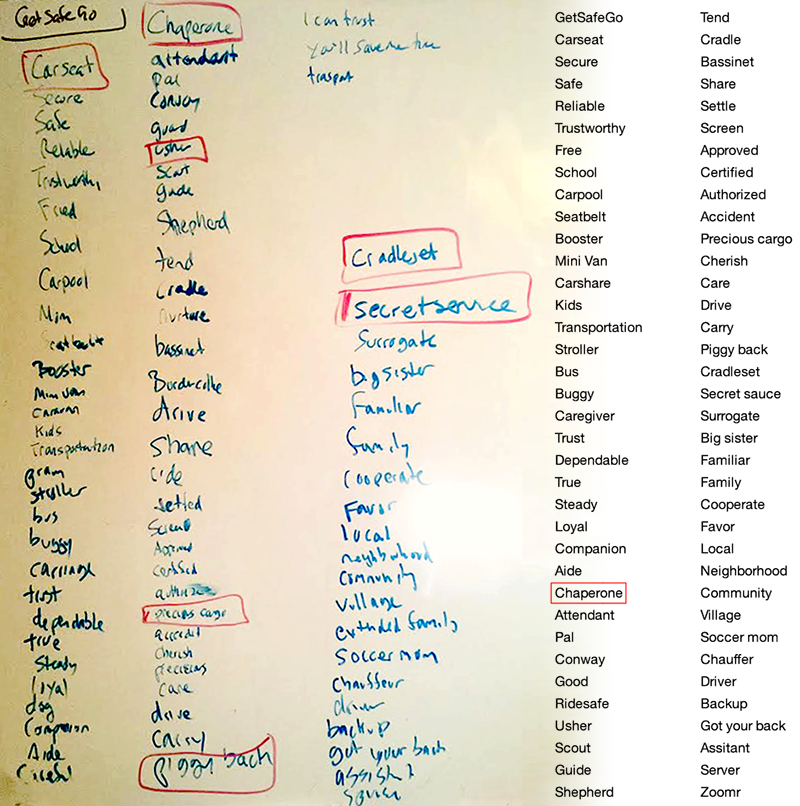
When we asked our parents what was #1 priority in letting someone else pickup their child and they all unanimously said ‘Trust.’ Parents trust Chaperones that volunteer with field trips among other things. Chaperones are parents from the community and can be trusted with children and their well-being.
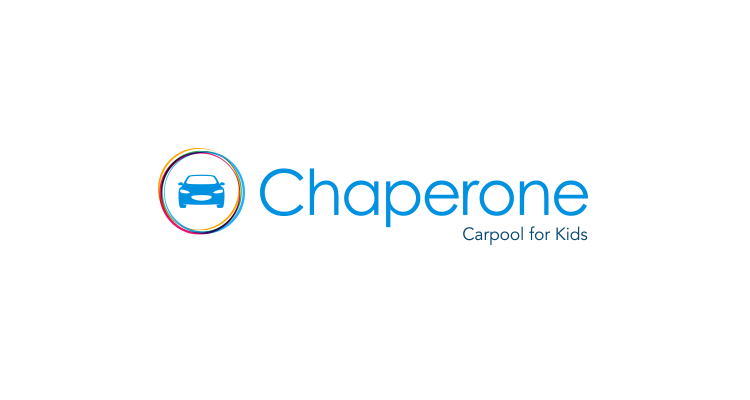

My approach was simple: Build a carpool community that is for the parents by the parents in partnership with the school. So we don’t just change how parents get their kids to schools, we fundamentally transform the schools transportation system. To illustrate the simplicity of our concept, we created a quick ‘lego’ movie and shared it with elementary students and their parents. The feedback helped us fine tune the user flow.
How it works
1. The app helps find a fellow from your community who needs rides and provides rides.
2. Parents meet each other in person and become part of Chaperone Network to make sure the rides are always safe and they have peace of mind.
3. The app gives the parents complete transparency and view over where their kids are during these rides.
4. Chaperone partners with schools to allow them to subsidize transportation costs and help raise funds.
Version 1.0
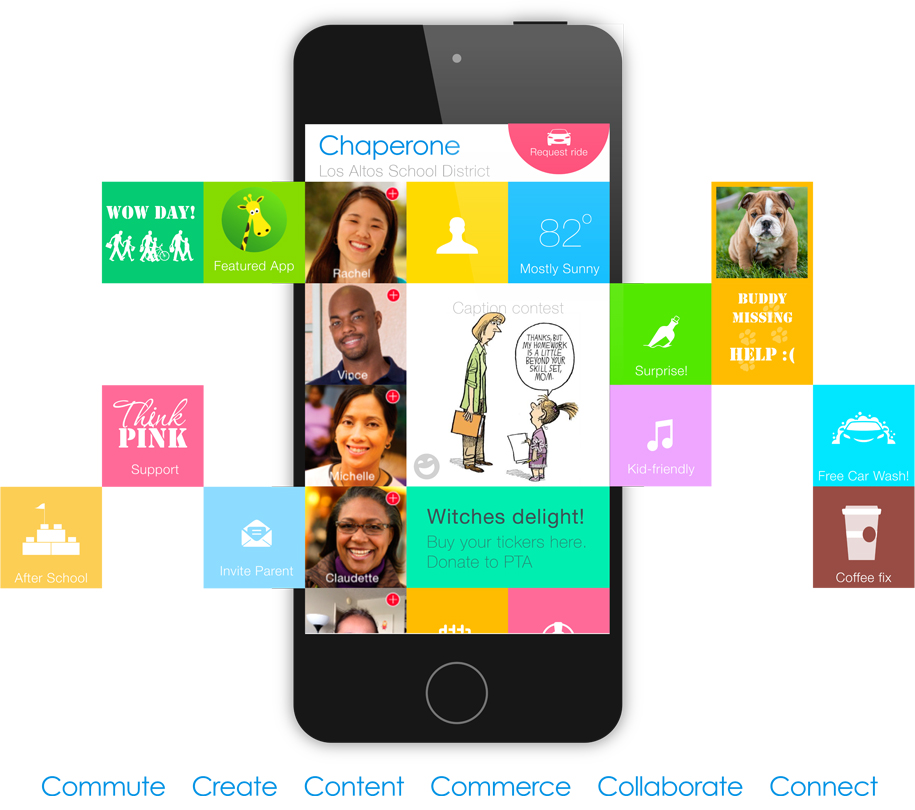
We launched the app before the school opened and tested with a wider audience. We got few things right and received lots of feedback to enhance the experience.
Version 2.0:
Here are a few screens of the new version. The focus is still on the ‘Direct’ user (Parent) while introducing features that allow the indirect users (children) and other user types to engage with the product.
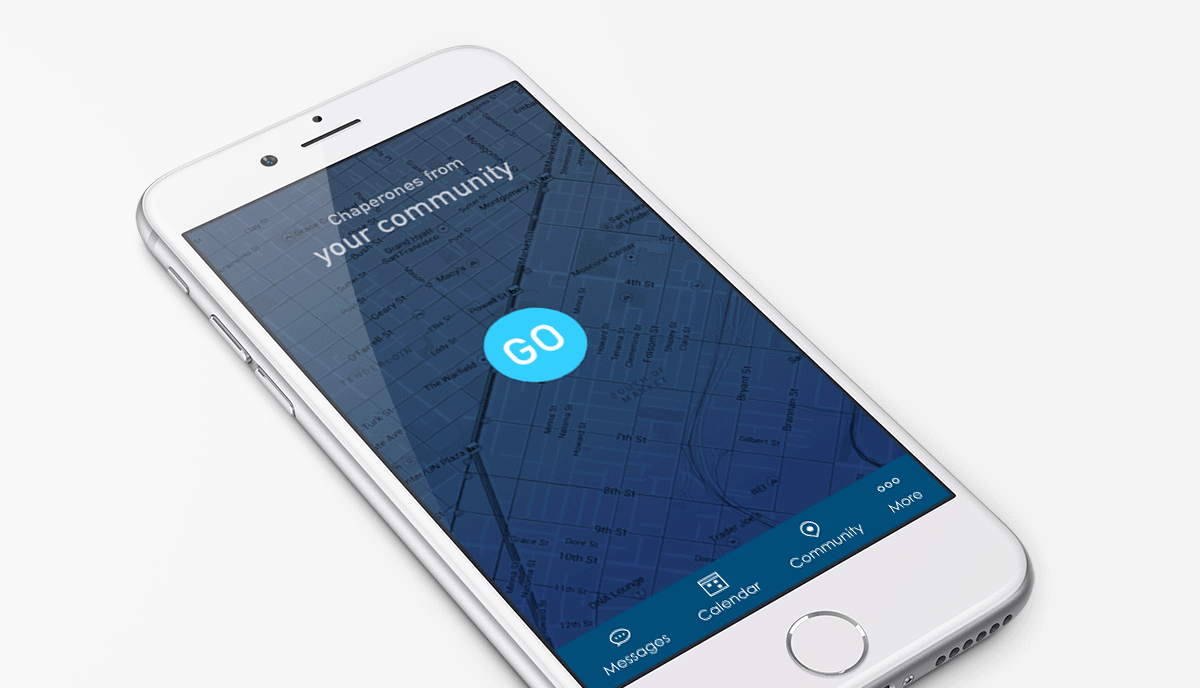
Home screen
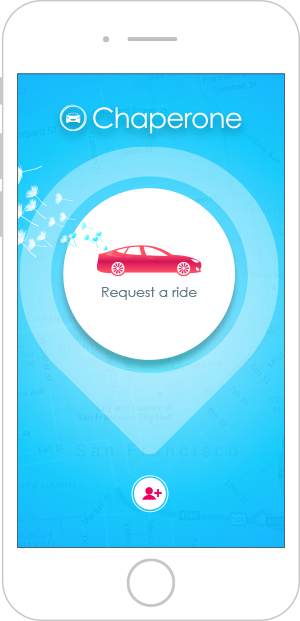
We made the screen smart and functional. Based on time, place, last activity and usage patterns the home screen updates and predicts the next move for the users and presents the appropriate action.
Request ride
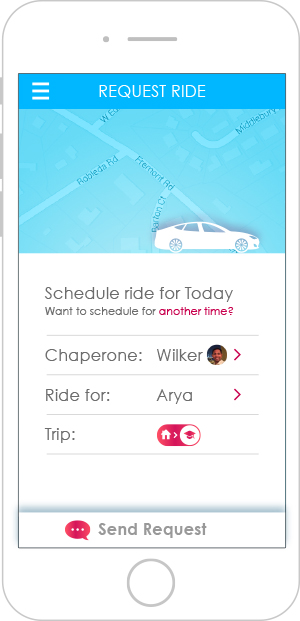
Based on our observation and data analysis, we noticed over 80% parents request the ride night before. We simplified the screen and populated all the relevant info predicting based on their past behavior. The use case went from four clicks to a single click.
Ride view

Knowing where our children are is natural and having live status of the ride gives the parents comfort. The app also tracks the speed, turns and braking to make sure the Chaperones are driving safely.
Carpool Impact
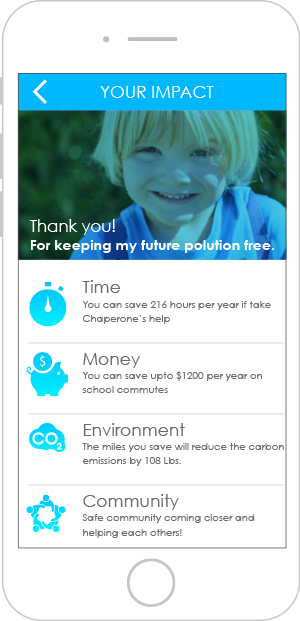
We want to recognize the efforts our Chaperones are making in helping the community and setting an ideal example for the children. Tracking the numbers helps them quantify their contribution and motivates them to share the service with fellow parents.

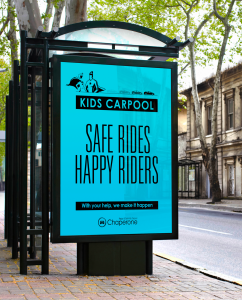 I set out to find a solution to solve a problem myself and fellow parents. We were successful in creating an app that is helping us and parents from over 300 schools. Most of these parents found us on the app store and are active users (6-9 times per week). The app is free to use and we have spent zero dollar in marketing. To date, the app has helped take 100s of cars off the road and helped reducing the traffic and pollution while delivering tons of smiles and friendships among kids and parents. It has been featured in local media as well as mentioned in WSJ.
I set out to find a solution to solve a problem myself and fellow parents. We were successful in creating an app that is helping us and parents from over 300 schools. Most of these parents found us on the app store and are active users (6-9 times per week). The app is free to use and we have spent zero dollar in marketing. To date, the app has helped take 100s of cars off the road and helped reducing the traffic and pollution while delivering tons of smiles and friendships among kids and parents. It has been featured in local media as well as mentioned in WSJ.
Personally, I also learned a lot about business, team building and startup challenges. As UX designer, we are always seeking solutions and entrepreneurship gives you a broader canvas to solve the problem.
As a family, we are carpooling with two other Chaperones. Our twins are back on the bike, and we continue to share the app with fellow parents and help the communities nationwide.

Back to Chaperone folio.


